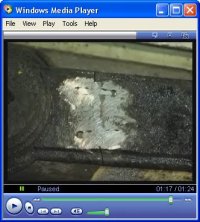 |
Conservation of Cast & Wrought Iron |
 |
|
|
7 Repair Techniques - Cold
| Cold repairs avoid the thermal stresses and fire/fume-risk of hot processes,
and so are particularly suitable for repairing cast iron, and for use in
historic buildings. Cold processes also generally employ simpler/cheaper
equipment, and should be adopted in preference to hot techniques where possible.
Traditional ‘grey’ cast iron contains flakes of graphite which lubricate
cutting operations such as drilling and tapping (threading) holes. All the
techniques described in this section are commonly used for repairing cast iron
|
 |
Plating - A strong and discreet repair can often be achieved by bolting a steel
plate across a cracked component on a hidden face. Plates must be bedded on
red-lead or two-pack epoxy putty to exclude water, and can be secured with
counter-sunk screws for a neater appearance. If stainless steel plates or
fastenings are used they must be physically/electrically isolated from the
casting to prevent dissimilar-metals corrosion. Stainless steel bolts can be
insulated by painting with two-pack epoxy primer and assembled before the paint
cures.
Structures are increasingly being repaired or strengthened by bonding on
plates of carbon or glass-fibre. (see below).
Studding - Broken rod-shaped components can be repaired by drilling and tapping
both parts and screwing together onto a threaded bar (studding), bedded on
red-lead or two-pack epoxy putty. If components cannot be rotated, the studding
can be screwed into one part and secured by epoxy putty into the other.
Carbon/Glass Fibre repair/strengthening - Filaments of carbon or glass are
bonded with two-pack epoxy resin onto a blast-cleaned surface to strengthen a
component or repair a crack. Preformed and tensioned plates may also be used to
upgrade structural strength.
Stitching - A modernised traditional technique for repairing
castings in which holes are drilled across a crack, slotted, and a ferrous lock
or ‘stitch’ is driven in to tie the sections together. Advantages: Cold process
requiring only portable hand tools. Safe on site. Hermetically tight, no sealants
used. Invisible on completion. Disadvantage: Not suitable for thin sections. |
|
|